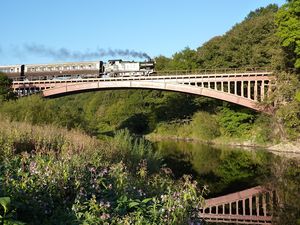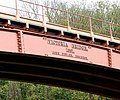Victoria Bridge
Victoria Bridge (Bridge 15) carries the Severn Valley Railway across the River Severn ½ mile south of Arley. It is the only place between Shrewsbury and Hartlebury where the railway crossed the river.
Contents
Construction
The bridge was designed by the Severn Valley Railway's chief engineer, John Fowler. It is largely constructed from cast iron; manufacture of the ironwork was subcontracted to the Coalbrookdale Company. The foundation stone was laid on November 24th 1859 by the SVR's resident engineer, Henry Orlando Bridgeman, and the bridge was completed in May 1861. Its span, of 200ft, was at the time the largest iron arch span in the country.[1]
It was reported at the time of construction that a defective rib casting was tested to destruction under a load of 430 tons.[2]
There is a near-identical double track railway bridge spanning the river Severn upstream at Buildwas. This bridge is known as Albert Edward Bridge, named after the eldest son of Queen Victoria, who was later crowned as Edward VII.
The bridge is listed Grade II* by Historic England for its special architectural or historic interest.[3]
The wording on each side of the bridge reads " Messrs. Brassey & Co., Contractors." "Victoria Bridge 1861 John Fowler, Engineer" "Cast and erected by the Coalbrookdale Company"
Although the deck of Victoria Bridge was built to single track width, the abutments were built wide enough for double track, meaning the bridge could have relatively easily been converted to double track.
The original 1852 estimate for the construction of the Railway, which included £8,500 for "a girder bridge at Arley",[4] also showed the station at Bridgnorth sited in the Low Town, east of the river. Although more convenient for the public, this would have required two further bridges, one south of the town near Quatford costing £8,000 and another north of the town near the present day golf course costing £9,000. A fourth bridge costing £10,000 was included near Shrewsbury in order to reach a junction with the Shrewsbury and Chester Railway. Cost saving measures adopted in the final railway plans resulted in the line remaining on the west bank and passing under High Town through Bridgnorth Tunnel instead, and joining the Shrewsbury & Hereford Railway, removing the need for these additional bridges.[1]
Victoria Bridge in commercial operation
The bridge was subject to restrictions on the weights and types of locomotives which could be worked ‘coupled’ or ‘double-headed’ over it. The definitions of classes such as "Blue", "Yellow" etc. may be found here.
The following restrictions were set out in the BR(W) 1948 working timetable:
Engines in the "Blue" group and the following engines in the "Yellow" group are prohibited from working double-headed over Victoria Bridge, Arley; Tank Engines of the 2-6-2, 0-6-2 and 0-6-0 classes, but they may be assisted by "Uncoloured" tender engines. Other "Yellow" engines may be assisted by any other permitted engine except that "Yellow" tank engines must not be coupled together.
When tender and tank engines are worked double-headed, the tank engine must be next to the tender.
By June 1963, shortly before closure of the line, BR(W) had re-drafted the restrictions to read as follows:
1. Permitted engines in the “Blue” Group and 55xx, 36xx and 74xx must not be coupled to any other engine.
2. 32xx may work coupled or coupled to an engine in the “Uncoloured” group.
3. When a tender engine and a tank engines are coupled, the tank engine must be coupled to the tender of the tender engine.
4. Not more than two engines may work coupled.
The '36xx' class included the 57xx class pannier tanks; an example of the impact of these restriction being that 5764 and 7714 would not have been permitted over the bridge while coupled together.
Victoria Bridge in preservation
The SVR began operations to Bewdley via Victoria Bridge in 1974. In that year they carried out a structural analysis of the bridge, which suggested that a loading of two tender locomotives with carriages would generate stresses in the main structure of the bridge not exceeding 2.6 tons/sq in (tension) and 6.2 tons/sq in (compression) against ultimate strength values of cast iron of 10 tons/sq in (tension) and 45 tons/sq in (compression). However it appeared that the bridge had last been re-decked by BR in the early 1950s, meaning a close watch would be kept on it.[2]
The railway photographer Paul Riley was killed by a fall from Victoria Bridge in August 1976.[5] Lineside photographers are not currently permitted to cross Victoria Bridge on foot.[6]
The bridge has featured in several films and television series, of which the best known appearance is probably the scene in 1978 film The Thirty Nine Steps where Richard Hannay (Robert Powell) escapes from a train and hangs beneath the bridge. The bridge also appeared in the 1977 Walt Disney Productions live action film Candleshoe and the 1987 TV series Knights of God.
In 1978 the Board was advised that the time had come for a major refurbishment of the bridge. This began in November 1979; the work included the installation of 54 new steel beams to replace the old (rotten) transverse timber baulks which formed the decking, replacement of more than 50% of the plate-work by 6 tons of new top plate, and the replacement of 3,500 rivets by high tensile friction grip bolts. The amount of plate replaced was necessary to achieve the required structural strength for a 21 ton axle load as specified by the Railway Board. At the same time the bridge received a complete repaint using 1,200 litres of paint. The scaffolding used around 2 miles of tube and 2½ miles of planking. The final cost was approximately £94,346, equivalent to almost £½ million at 2015 prices. Despite adverse weather, the line was re-opened on time for Easter 1980,[2] although the winter closure meant that Santa services were moved to the north end of the line.[7]
Another major refurbishment was carried out during the winter of 2003-04. The estimated cost was £320,000, of which a significant portion related to scaffolding. The work included the replacement of the 1970s wooden bridge deck with a new steel mesh deck. The bridge was re-opened by a young lady named Victoria Bridge from Cradley Heath. It was her first visit to the SVR.[8] The refurbishment received a commendation in the Institution of Civil Engineers’ 2005 Historic Bridge and Infrastructure Awards.
To preserve the structure the bridge has a permanent speed limit of 15 mph and is also subject to operating restrictions which means that two large engines may not work double headed over it.
Gallery
Storm damage after the 2007 floods.
See Also
References
- ↑ 1.0 1.1 Nabarro, G (1971), Severn Valley Steam
- ↑ 2.0 2.1 2.2 SVR News 58, article by the consulting engineer to the 1979-80 refurbishment
- ↑ Victoria Bridge on the Historic England list
- ↑ Handbook to the Severn Valley Railway, by J. Randall 1863
- ↑ Krause, I, Paul Riley - An Appreciation, retrieved 28th January 2015. Link
- ↑ SVR (H) corporate document SMS-POL-135, Lineside Photographic Policy (Permits & PTS Course), Issue 1 (19th September 2012). Link to download page
- ↑ SVR News 54
- ↑ SVR News 146










